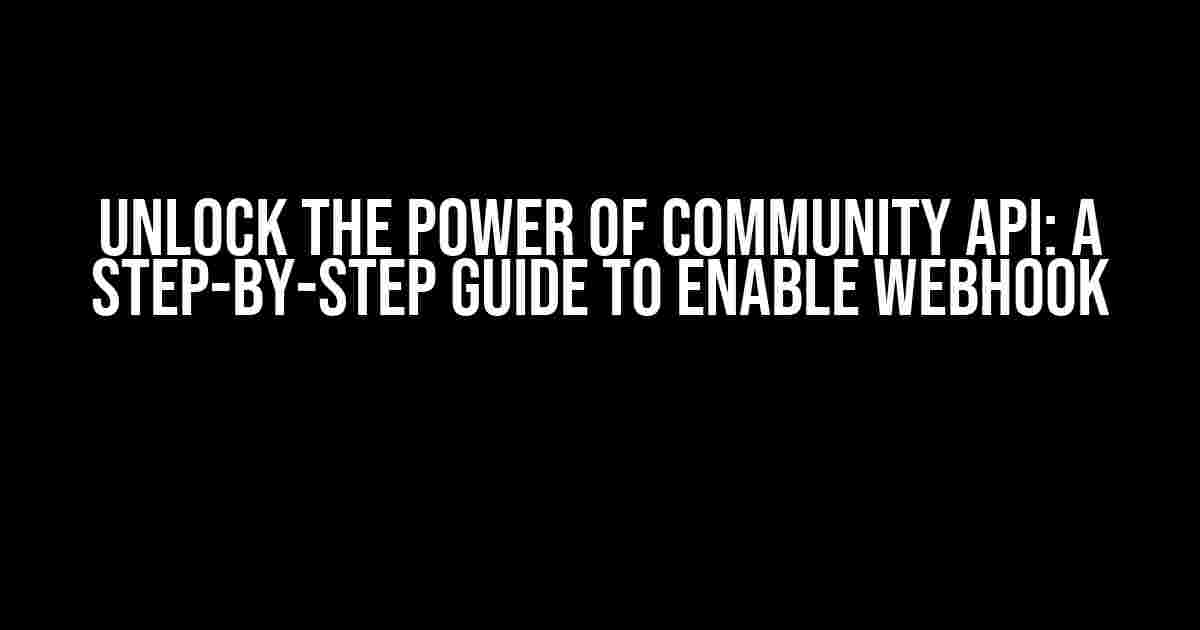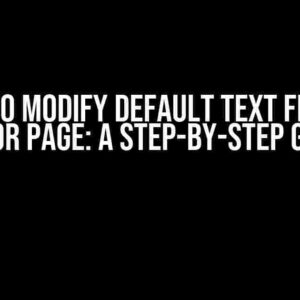Are you tired of manually checking for updates and changes in your community API? Do you want to streamline your workflow and automate tasks with ease? Look no further! Enabling webhook for your community API is the solution you’ve been waiting for. In this comprehensive guide, we’ll walk you through the process of enabling webhook, explaining the benefits, and providing you with actionable steps to get started.
- What is a Webhook?
- Benefits of Enabling Webhook for Community API
- Prerequisites for Enabling Webhook
- Step 1: Access the Community API Dashboard
- Step 2: Navigate to the Webhook Settings
- Step 3: Create a New Webhook
- Step 4: Configure Webhook Triggers
- Step 5: Set up Authentication
- Step 6: Implement Webhook Handler
- Conclusion
- FAQs
What is a Webhook?
A webhook is a callback function that notifies your application when a specific event occurs. It’s a powerful tool that allows your application to respond to changes, updates, or events in real-time, without requiring manual intervention. Webhooks are commonly used in APIs, social media platforms, and other online services to enable seamless communication between systems.
Benefits of Enabling Webhook for Community API
Enabling webhook for your community API can bring numerous benefits, including:
- Real-time Notifications: Receive instant notifications when a new comment, post, or update is made, allowing you to respond promptly and engage with your community more effectively.
- Automated Workflows: Trigger automated tasks and workflows based on specific events, such as sending welcome emails to new members or assigning tasks to team members.
- Enhanced User Experience: Provide a more personalized and responsive experience for your community members, by enabling real-time updates and notifications.
- Improved Efficiency: Reduce manual labor and increase productivity by automating repetitive tasks and focusing on high-value activities.
Prerequisites for Enabling Webhook
Before you begin, ensure you have the following:
- A community API account with administrative privileges.
- A basic understanding of API integration and webhook concepts.
- A server or application capable of receiving webhook notifications (e.g., Node.js, Python, or Ruby).
- A valid API key or access token for authentication.
Step 1: Access the Community API Dashboard
Login to your community API dashboard using your administrative credentials. The dashboard may vary depending on your community API provider, but most will have a similar layout.
Step 2: Navigate to the Webhook Settings
Locate the webhook settings section within the dashboard. This is usually found under the “Settings” or “Integrations” tab. Click on the relevant option to access the webhook configuration page.
Step 3: Create a New Webhook
Click on the “Create Webhook” or “Add Webhook” button to create a new webhook. You may be prompted to enter a name, description, and endpoint URL for your webhook.
| Field | Description |
|---|---|
| Name | A descriptive name for your webhook (e.g., “Community API Webhook”). |
| Description | A brief description of your webhook (e.g., “Receives community API updates”). |
| Endpoint URL | The URL where your application will receive webhook notifications (e.g., https://example.com/webhook). |
Step 4: Configure Webhook Triggers
Select the events that you want to trigger your webhook. These may include:
- Comment created
- Post updated
- Member joined
- Task assigned
You can choose one or multiple events, depending on your specific requirements.
Step 5: Set up Authentication
Configure authentication for your webhook by selecting an authentication method:
- API Key: Enter your community API key or access token.
- OAuth: Select this option if you have an OAuth token or want to use OAuth for authentication.
Make sure to save your changes and test your webhook configuration.
Step 6: Implement Webhook Handler
Create a webhook handler in your application to receive and process webhook notifications. This will involve writing code to handle incoming requests and respond accordingly.
// Node.js example using Express.js
const express = require('express');
const app = express();
app.post('/webhook', (req, res) => {
// Process webhook notification
console.log(req.body);
res.send('Webhook received!');
});
app.listen(3000, () => {
console.log('Webhook server listening on port 3000');
});
Conclusion
Enabling webhook for your community API is a straightforward process that can revolutionize the way you interact with your community. By following these steps, you’ll be able to automate tasks, receive real-time notifications, and provide a more personalized experience for your members. Remember to test your webhook configuration and implement a robust webhook handler to ensure seamless integration with your application.
FAQs
Q: What is the difference between a webhook and an API call?
A: A webhook is a callback function that notifies your application of an event, whereas an API call is a request made to an API to retrieve or modify data.
Q: Can I use multiple webhooks for different events?
A: Yes, you can create multiple webhooks for different events or triggers, allowing you to customize your workflow and automation.
Q: How do I troubleshoot webhook issues?
A: Check your webhook logs, verify your endpoint URL, and test your webhook configuration to identify and resolve any issues.
Q: Are webhooks secure?
A: Webhooks use standard HTTP protocols and can be secured using encryption (HTTPS) and authentication methods (API keys, OAuth). However, it’s essential to implement proper security measures to protect your application and data.
By following this comprehensive guide, you’ll be well on your way to unlocking the full potential of your community API with webhooks. Happy integrating!
Frequently Asked Question
Get answers to the most commonly asked questions about enabling webhooks for Community API.
What is a webhook, and why do I need it for Community API?
A webhook is a callback function that allows your application to receive real-time notifications when specific events occur within the Community API. You need it to enable seamless communication between your app and the API, ensuring that you receive instant updates and can respond promptly to changes.
How do I enable webhooks for my Community API?
To enable webhooks, head to your Community API dashboard, navigate to the ‘Settings’ tab, and click on ‘Webhooks’. From there, you can add a new webhook by providing a unique name, selecting the events you want to receive notifications for, and specifying the URL that will receive the payload. Don’t forget to save your changes!
What types of events can I receive notifications for via webhooks?
You can receive notifications for a wide range of events, including new messages, topic creations, user registrations, and more. The specific events available for webhook notifications may vary depending on your Community API plan and configuration.
How do I verify the authenticity of webhook notifications?
To ensure the authenticity of webhook notifications, you can use the signature header included in each payload. This signature is generated using a secret key that you can find in your Community API dashboard. You can then verify the signature on your end to ensure that the request comes from a trusted source.
What happens if I miss a webhook notification?
Don’t worry! If you miss a webhook notification, you can always retrieve the missed event data by querying the Community API’s event history. This ensures that you never lose track of important updates and can always stay up-to-date with the latest changes.





